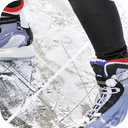(short preview of full seamless looping track)
Ice Skating
This product is not available in the selected currency.
In Stock
Backordered
Out of Stock
Description
The smooth field of ice is a super wintertime space to feel like you can fly. The crisp air tickles your red nose and a slight icy spray flies in your face as expert skating enthusiasts grind to a halt in front of you. After a few bumps and bruises you finally get the hang of handling the balancing act, allowing you to impress the group of giggling onlookers pointing your way. A study by Federico Formenti of the University of Oxford suggests that the earliest ice skating happened in southern Finland about 4000 years ago. Originally, skates were merely sharpened, flattened bone strapped to the bottom of the foot. Skaters did not actually skate on the ice, but rather glided on top of it. True skating emerged when a steel blade with sharpened edges was used. Skates now cut into the ice instead of gliding on top of it. Adding edges to ice skates was invented by the Dutch in the 13th or 14th century. These ice skates were made of steel, with sharpened edges on the bottom to aid movement. The construction of modern ice skates has stayed largely the same since then. Ice skating works because the metal blade at the bottom of the skate shoe can glide with very little friction over the surface of the ice. However, slightly leaning the blade over and digging one of its edges into the ice ("rock over and bite") gives skaters the ability to increase friction and control their movement at will. In addition, by choosing to move along curved paths while leaning their bodies radially and flexing their knees, skaters can use gravity to control and increase their momentum.
This sound uses the following file from Freesound: http://www.freesound.org/samplesViewSingle.php?id=66151
Opps
Sorry, it looks like some products are not available in selected quantity.



